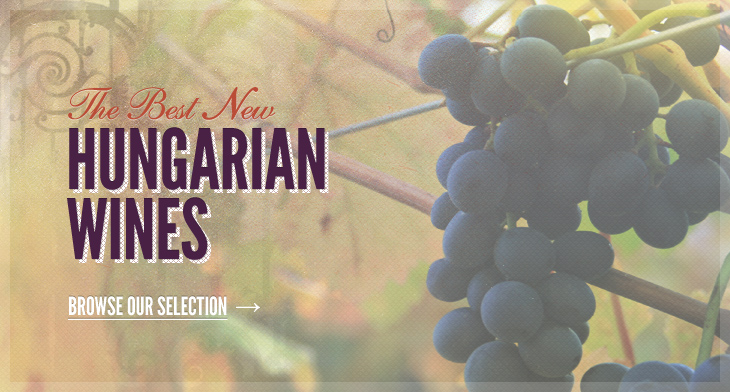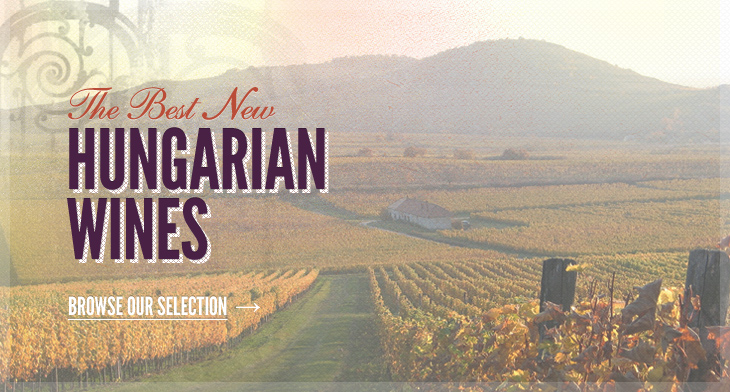No membership fees, no sign up! Just lots of good wine. And lots of good information too.
The Top Ten Hungarian Grapes

Hungarian winemakers use all sorts of exciting and unusual varieties of grape to make their wines…
- read more
- Posted on Presentations
The Hungarian Wine Society is the place to find that up-to-the-minute news on this most creative and historical wine country, as well as detailed information on her wine-making history, regions and grape varieties. Our wine list has been selected to give an introduction to each of the major regions and grape varieties of Hungary, and showcases some of the very best examples of winemaking emerging from the country – not only award winning wines, but winemakers too: our list includes several winners of The Hungarian Winemakers of the Year.
Sign up for our monthly newsletter to obtain exclusive monthly offers, or visit our Facebook page for regular news and updates on Hungarian wines.
And if you have any further questions please don’t hesitate to contact us.
Hungarian winemakers use all sorts of exciting and unusual grape varieties to make their wines, so forget about sticking to Chardonnay and Cabernet Sauvignon, and explore our guide to the top ten grapes you should get to know if you want to try something that little bit different:
1. Furmint (w) – as the most famous and most commonly grown grape in Hungary’s most famous wine region, Tokaj, Furmint had to be our number one Hungarian grape. It makes up about 70% of the vines found in Tokaj, and has also made a name for itself in the Somló region. Furmint is best known for being one of the three grape varieties used to make the sweet botrytised wines which have made Tokaj famous throughout the world, but it also produces fine, fiery dry wines, with high levels of acidity, which can make them good for aging.
2. Kékfrankos (r) – Hungary’s most widely planted blue grape (“Blue-Frankish”) was singled out by no less than Napoleon as a grape worthy of our attention. Fine acid and a good tannin structure with fruit of the forest flavours, and a sometimes spicy character. It is usually the single biggest component of Eger and Szekszárd’s Bikavér blends and in the past few years has changed from a grape renowned for producing easy drinking local wine to a Hungarian flagship, particularly in Szekszárd. It is the same grape as Austrian Blaufränkisch and German Lemberger.
3. Kadarka (r) – Kadarka was once the most famous red wine grape in Hungary, but its tendency to ripen perilously late, its susceptibility to disease, and the need to tightly control its natural vigour led to its virtual abandonment under Communism, in favour of Kékfrankos and Portugieser. When produced in small, concentrated yields it can produce seriously classy wines – fairly low in tannin, but with plenty of acidity, ripe red fruit flavours, and a spicy aftertaste. It is one of the compulsory and main constituent grapes in Bikavér, giving the blend its aroma and spicy aftertaste. The region of Szekszárd is particularly prized for its Kadarka, the grape is also grown on the Great Plain, and it is being reintroduced to Eger.
4. Hárslevelű (w) – This white grape may be hard to pronounce, but it is the second most widely planted grape in Hungary, and makes up approximately 18% of the vines in Tokaj. It is most famous as one of the three grapes that make up the sweet wines of Tokaji, where it is added to Furmint and Muscat to bring floral aromas and richness to the blend. These days it is also increasingly appearing on its own as dry varietal white. The name Hárslevelű translates as “Linden Leaf,” and good examples of Hárslevelű wines are powerfully aromatic, rich, green-gold, with Linden honey flavours. The Hárslevelű of Somló is particularly prized, where it produces wines with greater minerality and less aroma.
5. Olaszrizling (w) – Olaszrizling was widely planted throughout Central and Eastern Europe under Communism due to its high yields, and it remains Hungary’s most planted white grape, despite being introduced to the country less than a century ago. It is the same grape as Austria’s Welschriesling, although examples from Hungary tend to have more body than their Austrian counterparts due to Hungary’s warmer climate – Olaszrizling produced around Lake Balaton, Somló, and Eger is particularly prized. It responds well to aging in oak and has a unique bitter almond character. Despite the name it has no link to the Riesling grape of Germany.
6. Portugieser (r) – Common in Austria, Germany and Romania, as well as Hungary, but the Portuguese link suggested by the name is misleading, or at least unproven. Portugieser (previously known as Kékoportó) is an extremely prolific and high yielding grape, which made it popular under Communism, but the downside of this vigour is a tendency to produce large quantities of dull wine if not restrained. Enter the wine-makers of Villány: Portugieser’s stronghold, and Hungary’s most southerly and hottest wine region is producing shining examples of what can be done with this grape – well-coloured, lively red wines, a bit like Kékfrankos, but more full-bodied. Along with Kadarka and Kékfrankos it is also an ingredient of Bikavér. Portugieser also plays an important role in producing fresh fruity young wines in time for the important traditional feast of St Martin’s Day in Hungary (Nov 11th), drawing comparisons with the role of Gamay in Beaujolais Nouveau.
7. Irsai Olivér (w) – A relatively recent Eastern European cross breed of the Pozsony and Pearl of Csaba grapes, developed in the 1930s for table wines, the resulting Irsai Olivér ripens early and easily and produces wines known for their perfumed, Muscat-like aromas. Irsai Olivér wines are typically light and refreshing, with a juicy tropical fruit character on the palate.
8. Kéknyelű (w) – Unlike most of the grapes that start with “kek” (which translates as “blue” in Hungarian), Kéknyelű is a white grape, and the name translates as “blue stalk.” This venerated grape was once widely planted, but due to its extremely temperamental nature and tiny yields it came close to disappearing altogether during Communist times. It is now found almost exclusively on the north shores of Lake Balaton, where it produces small quantities of very unusual wines.
9. Muscat (r/w) – there are many types of Muscat grape, but the one we are most concerned with here is the extensively titled Muscat Blanc à Petits Grains, thankfully also known as Muscat Lunel or Yellow Muscat in Hungary. The oldest and finest grape in the Muscat family, it makes up about 8% of the plantings in Tokaj, and is the third major component of Tokaji Aszu. Lots of people ask why you can’t say a wine tastes of grapes – well, muscat is one of the varieties where you traditionally can, without expecting to be laughed at. Look out for orange flowers and spicy hints as well, and a strong perfume. Outside of Tokaj another variety of Muscat – Muscat Ottonel – is the most widely planted, and takes up considerably more hectares than Muscat Lunel.
10. Cabernet Franc (r) – Best known as a Bordeaux grape, where it is usually blended with Cabernet Sauvignon and Merlot. So what is it doing in our list here? Because many are saying that in Southern Hungary, where the grape plays more of a lead role than in Bordeaux and is often unblended, Cabernet Franc has found its natural home outside France. Hungary’s most notable examples come from the rival wine regions of Szekszárd and Villány, but Eger and the regions around Lake Balaton are hot on their heels. The climate and soil of Southern Hungary seem capable of producing unique examples of Cabernet Franc – complex and concentrated, chocolatey, with juicy red fruits and blueberries.
Keep an eye out for the following other grapes, which appear regularly in Hungarian wine offerings: Riesling (Rhein Riesling), Zweigelt, Szurkebarat (Pinot Gris/Pinot Grigio), Tramini (Gewurztraminer), Juhfark (“Sheep’s Tail”), Pinot Noir, Chardonnay, Sauvignon Blanc, Leanyka (“Maiden”), Merlot, Cabernet Sauvignon, Syrah, and Kiralyleanyka (“Princess”).





%20-%20cropped-78x275.jpg)
%20cropped-78x275.jpg)
%20-%20cropped-78x275.jpg)

%20cropped%20(2)-78x275.jpg)

